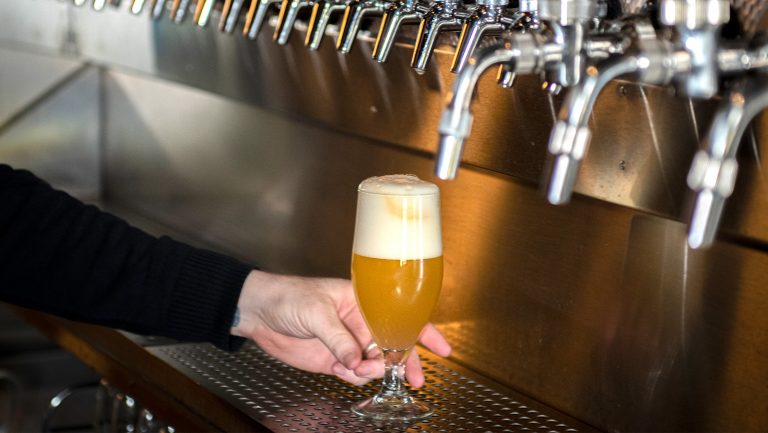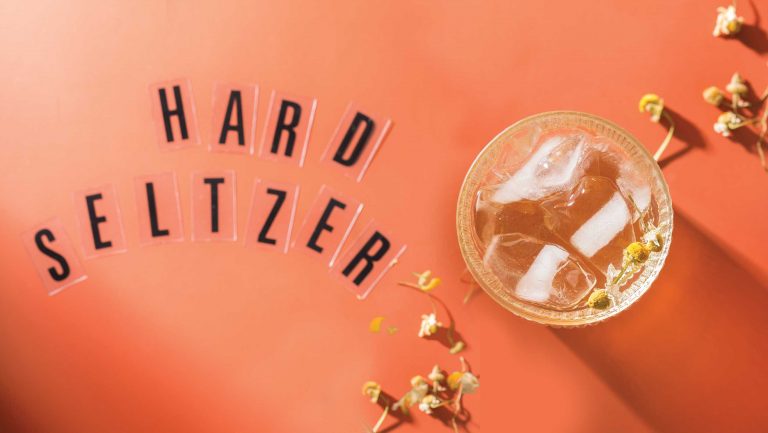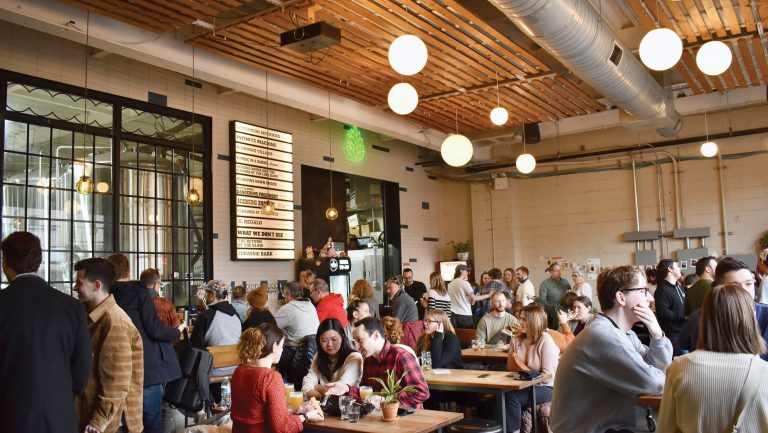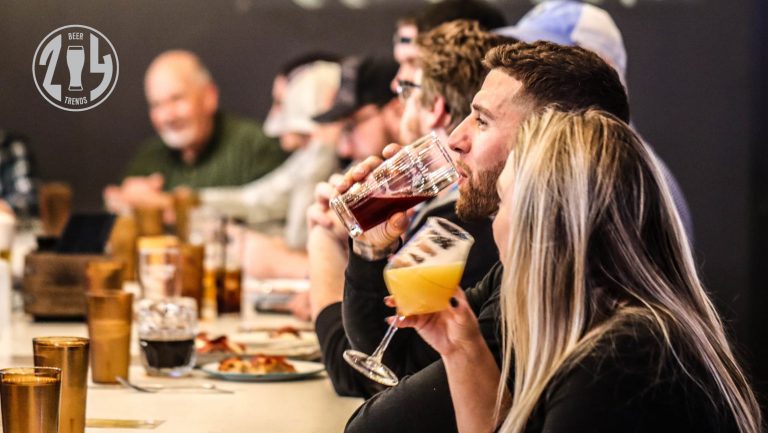Every Tuesday, local beer drinkers head to Human Robot Brewery for America’s foamiest happy hour. The lager-focused brewery’s two locations, in Philadelphia and nearby Jenkintown, sell cylindrical glasses filled with 10 ounces of foam for two bucks, a one-dollar discount. There’s no dawdling before drinking the so-called “milktube,” a spin on the all-foam Czech pour called mlíko (Czech for “milk”). Customers are encouraged to chug the foam, built from the brewery’s Czech-style amber lager, Polotmavy 12°, before it collapses into liquid.
“It’s almost an aperitif,” says Ken Correll, a partner in Human Robot. The dark lager’s dense, wet foam “leaves a little bit of cocoa on your palate, and then you’re ready to drink beer.”
American beer drinkers often treat foam as a flaw, not a feature, expecting mugs to brim with beer. Begone, bubbles! Big mistake. Foam is an indicator of a capably constructed beer, and a fluffy cap helps capture fast-vanishing volatile aromatics and protect beer from ruinous oxygen. Varying levels of foam can also impact a beer’s carbonation level, leaving it crisper or softer and better tailored to different food.

Don’t miss the latest drinks industry news and insights. Sign up for our award-winning newsletters and get insider intel, resources, and trends delivered to your inbox every week.
As crowds return on premise, bars and taprooms are increasingly pouring beers to precise, and sometimes purposefully excessive, foamy heights. The bubbly pageantry offers consumers a compelling reason to pony up for pints in person. “You’re not going to get this out of the can,” says Lindsay Steen, a founder of Wild East Brewing in Brooklyn, which serves its lagers with several different kinds of foam.
Bringing American Drinkers Around to Foam-Heavy Pours
Typically, bars and taprooms install standard faucets that pour most beers fairly well. Pull the tap forward, beer flows out. But the open-close mechanism makes it tough to fine-tune foam. That’s why breweries are increasingly installing the Czech company Lukr’s side-pull faucets, which let bartenders control a beer’s flow and produce lustrous foam that serves as a lager’s final ingredient.
Czech beer culture champions several distinct pours including the smooth hladinka, in which three fingers of foam crown a beer, and the cutting na dvakrá (“crisp”). The all-foam mlíko is served alongside the šnyt, which features a bit more foam than beer and leaves head space in a mug.

Notch Brewing in Salem, Massachusetts, was one of the earliest adopters of Lukr faucets, as well as Bierstadt Lagerhaus in Denver. Now you’ll find side-pull faucets facilitating foam-capped pours nationwide, from Seedz Brewery in Union Pier, Michigan, to Marshall Brewing in Tulsa, Oklahoma.
“If you told me 10 years ago that it would be within social norms to order a glass of foam and most craft breweries would have it, I would have totally laughed you out of the room,” says Vince Tursi, the cofounder and head brewer of Dssolvr in Asheville, North Carolina.
The brewery opened in 2019 with abundant IPAs and two side-pull faucets used to pour Dssolvr’s lagers, including a mlíko option. Initially, its appearance on the menu caused some expected confusion. “We definitely got people who were like, ‘Milk? No, I don’t want milk. Can I just have beer?’” says Tursi.
Over time, the mlíko pour found a steady following, especially as the lowest-priced beer in a taproom that offers neither tasters nor flights. Dssolvr charges $3 for a nearly 17-ounce stein filled with foam, or the equivalent of around eight ounces of beer upon settling. “The entry fee is very low to explore something new,” says Tursi. And one foamy round can sell another one. “People drink with their eyes.”
Denver is a crowded beer city, but Eric Larkin found a foamy niche with the Czech-inspired Cohesion Brewing, which opened last August. Cohesion pours its low-alcohol, Czech-style lagers with four different kinds of foam, each presentation illustrated and described on the menu, including a five-ounce “milk shot” that costs $2. “People will come in and order two milk shots and two beers,” says Larkin, the head brewer and cofounder. “They’ll start off with that milk shot and then have a regular beer.”
If customers ever express uncertainty about Cohesion’s foam-forward approach to service, bartenders will dole out free tastes of foam. “They’ll say, ‘You can drink it and tell us if you think it’s worth drinking,’” says Larkin. “It’s almost a slam dunk every time.”

When it opens later this summer, Sacred Profane in Biddeford, Maine, will offer a minimal beer selection and maximal commitment to service. “You’ll be taken care of down to the last drop of beer,” says Brienne Allan, the head brewer of the “tankpub” where fresh beers will be dispensed from highly visible serving tanks, not kegs.
Sacred Profane plans to only produce two draft beers, a Czech-style pale and dark lager, that will be poured through side-pull faucets. Each beer will have five different pours, and “we’ll be educating everyone on why there’s different amounts of foam,” says Allan.
The tankpub will approach pairing food to specific pours that can alter the carbonation levels of a beer. “You should be changing the amount of foam you have depending on what you’re eating,” says Allan. For example, she says, chocolate mousse excels with a foam-rich pour that will complement sweetness and richness, while a spicy dish is ideal with a beer topped with little to no foam, letting the effervescent carbonation to cut and refresh.
“People are being told right now to accept foam but they’re not being told why,” says Allan. Educated service is “a really important piece of the puzzle.”
Bars Install Side-Pull Faucets
As taprooms embrace side-pull faucets, more bars are rethinking their approach to designing draft systems. The recent crop of beer bars, including Brooklyn’s woman-owned Beer Witch and The Beer Keep in Buffalo, pour lagers through side-pulls. Correll of Human Robot is also an owner of Memphis Taproom, a Philadelphia beer bar that opened in 2008 with zero side-pull faucets. Now the bar has two Lukr faucets that are used to pour Czech-style and rustic lagers. “We had to pick it up a notch,” says Correll, who installed a tower with three Lukr faucets at Human Robot’s Jenkintown location that opened in March.
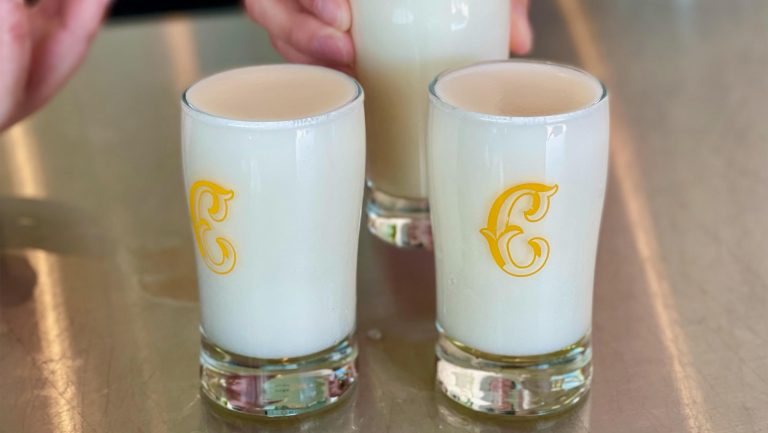
For two years during the pandemic, the Washington, D.C., beer bar ChurchKey sat shuttered. The forced downtime led Greg Engert, the beer director and a managing partner of Neighborhood Restaurant Group (NRG), the parent company, to rethink the bar’s draft system that featured 50 standard taps and five suited for cask ales. “We knew we were always pouring at least five lagers,” says Engert.
A Lukr faucet requires more horizontal space than a standard tap, so a simple swap was unfeasible. ChurchKey instead downsized to three cask ales, providing the space to install five side-pull faucets prior to the bar reopening in April. “We want to make sure that we have the type of service techniques that can best showcase the flavor profiles of beer styles,” says Engert.
American brewing is adept at finding inspiration elsewhere and adapting it stateside, sometimes according to tradition, other times by breaking orthodoxy. The current approach to foam can sometimes be over-the-top, but it’s another step in craft brewing’s continuing evolution of going to the extremes before finding a new normal.
This fall in New Orleans, NRG is planning to open Brewery Saint X, which will focus on classic beers and “lagers galore,” says Engert. There will be around 12 drafts, half of which will be poured via side-pull taps, a new starring role for foam and service. “Craft beer finds a way to revitalize and reimagine itself,” says Engert.

Dispatch
Sign up for our award-winning newsletter
Don’t miss the latest drinks industry news and insights—delivered to your inbox every week.
Contributing editor Joshua M. Bernstein is a beer, spirits, food, and travel journalist, as well as an occasional tour guide, event producer, and industry consultant. He writes for the New York Times, Men’s Journal, New York magazine, Wine Enthusiast, and Imbibe, where he’s a contributing editor in charge of beer coverage. Bernstein is also the author of five books: Brewed Awakening, The Complete Beer Course, Complete IPA, Homebrew World, and Drink Better Beer.

